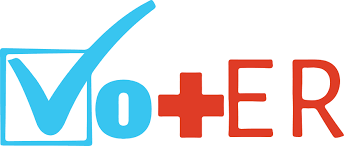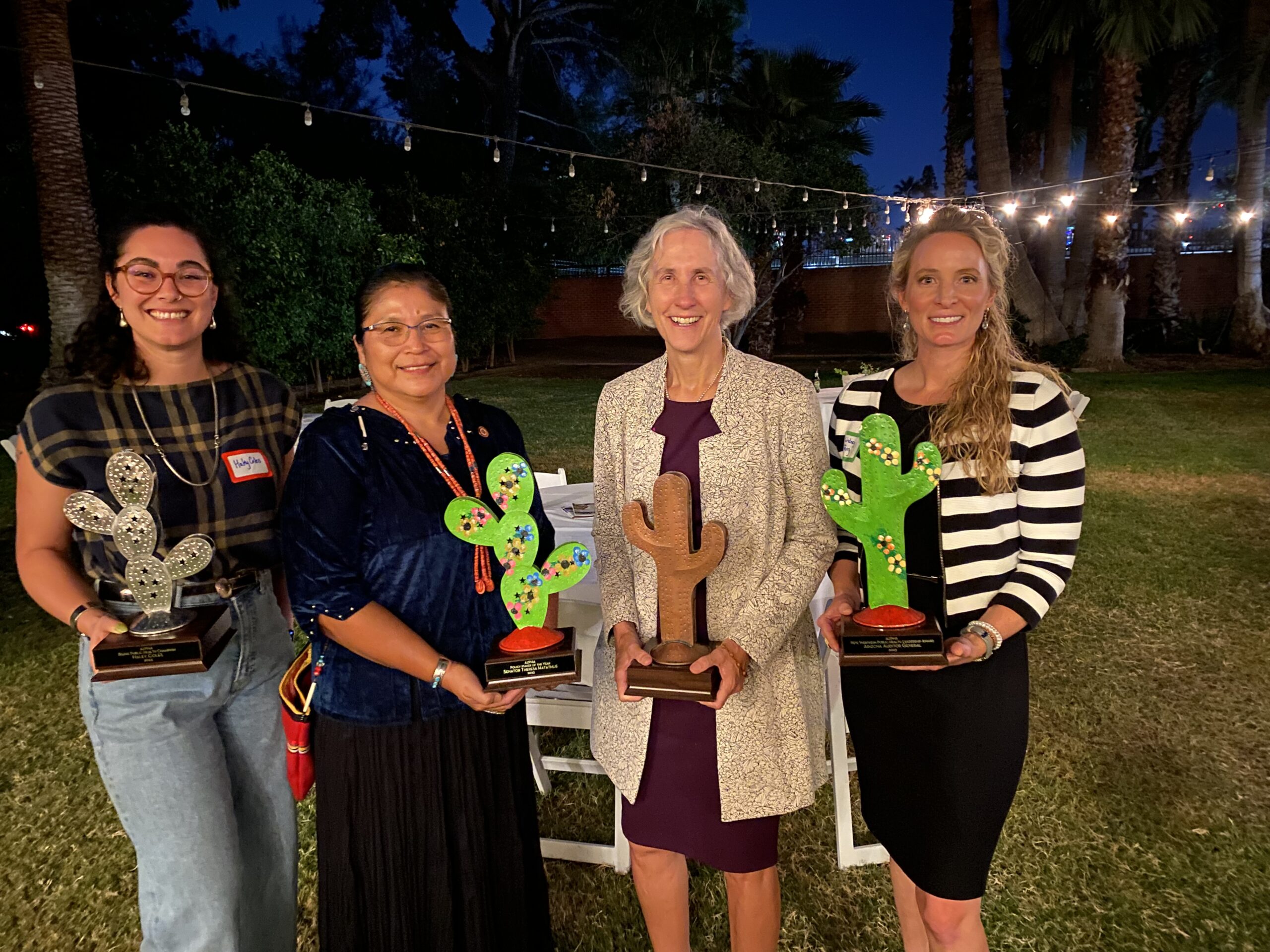|
|
Register HereAugust is Civic Health Month—a time to showcase the link between voting and health and celebrate efforts that ensure each and every voter has the opportunity to support their community’s health at the ballot box. Every August, over 300 organizations nationwide, including the American Medical Association, Massachusetts General Hospital, and the National Medical Association,join together to celebrate, learn, and take action to improve the civic health of their communities. In this discussion you will learn how hospitals and clinics across the country transform into centers of democratic engagement by using Vot-ER tools. Sandra Gutierrez is the Western Region Deputy Field Director for Vot-ER. Based in Tucson, AZ Sandra loves engaging voters at the local and state level. She has over a decade of community organizing experience and is committed to making a difference in her community by volunteering as the current Moms Demand Action, Tucson Chapter Lead. Sandra’s passion comes from working to prevent others from experiencing gun violence. When she is not working or tabling a local Moms Demand Action event Sandra spends time with her husband and 8 year old son. They love cheering on University of Arizona Baseball, enjoying live music, and visiting Mt. Lemmon. VOT-ER is a nonpartisan nonprofit organization, working to integrate civic engagement into healthcare. At the core of their work is the premise that healthcare professionals are trusted messengers who can make the connection between health and voting. Sandra Gutierrez is the Western Region Deputy Field Director for Vot-ER. Based in Tucson, AZ Sandra loves engaging voters at the local and state level and has over a decade of community organizing experience. |
CMS Flexing Their Muscles to Drive Healthcare Quality Improvements
As the dominant payer for hospital & long-term nursing care in the US, the Centers for Medicare & Medicaid Services have considerable leverage over the healthcare industry – when leadership chooses to use it.
It’s refreshing to see CMS continuing to creatively use this leverage to push for higher standards of care in their newly finalized regulations that dictate certain requirements that need to be met in order for a provider to be able to participate in Medicare or Medicaid.
These changes, which take effect on October 1, 2024, are part of the FY 2025 Hospital Inpatient Prospective Payment System & Long-Term Care Hospital Prospective Payment System Final Rule.
The updated requirements focus on improving patient outcomes and ensuring that Medicare and Medicaid funds are used to support quality care. Here are some of the key features of the new rules:
Long-Term Care Hospital Quality Reporting
Long-term care facilities (nursing care facilities) provide critical care to patients with complex medical needs, often over extended periods- and CMS is also the dominant payer for these services – giving them tremendous leverage.
The updated Quality Reporting Program for skilled nursing facilities will now require more comprehensive reporting on various quality measures, including patient outcomes and healthcare-associated infections.
These changes are designed to incentivize them to focus on preventing infections and improving overall patient safety. By refining the reporting requirements, CMS is driving long term care facilities to prioritize quality care for some of the most vulnerable patients in the healthcare system.
Reducing Hospital Readmissions
Reducing unnecessary hospital readmissions has been a longstanding goal of CMS ever since the Affordable Care Act was implemented (which introduced the opportunity to drive positive change by punishing hospitals that have too many unnecessary hospital readmissions (usually due to poor discharge planning).
The new rules now include refined measures that better reflect the complexities of patient care and the various factors that contribute to readmissions. By penalizing hospitals with higher-than-expected readmission rates, CMS is encouraging providers to improve discharge planning, follow-up care, and patient education— core elements in reducing readmissions and enhancing overall patient outcomes.
Reducing Hospital-Acquired Conditions & Infections
Hospital-acquired conditions are avoidable infections and complications that can lead to significant patient harm. CMS’s updated HAC Reduction Program in the upcoming regulations aims to reduce the incidence of these conditions by penalizing hospitals who have high HAC rates.
The new regulations introduce updated measures and benchmarks that align more closely with the latest evidence on preventing these conditions.
Hospital Respiratory Infection Data Reporting
For the last 4 years CMS has been placing a strong emphasis on the importance of respiratory infection data. The new regulations require hospitals to report detailed data on respiratory infections that can be used tracking trends, identifying potential outbreaks early, and improving preparedness for future respiratory pandemics.
By mandating these reports, CMS is requiring hospitals who want to continue to get reimbursement from Medicare or Medicaid to improve their infection control practices and to be more vigilant in monitoring and responding to respiratory health threats.
Brief Mention of Other Changes
In addition to these major updates, CMS has also amended other programs, such as the Value-Based Purchasing Program and the Medicare Promoting Interoperability Program. These updates are part of a broader strategy to improve care quality across the healthcare system.
These new rules demonstrate that the agency under (its current leadership) is committed to using its considerable power to drive meaningful improvements in healthcare quality.
These new welcome regulations – which focus on reimbursement incentives – (both carrots and sticks) signal a positive shift towards a more accountable and patient-centered healthcare system, ultimately benefiting patients, taxpayer, and those who contribute to the Medicare Trust Fund through their payroll taxes.
Assistance Needed: Help with the New AZ Rural Health Needs Assessment
The Arizona Rural Women’s Health Network is requesting your assistance and input to identify and prioritize the health issues/topics impacting women and health providers in our rural communities.
The information you provide will help guide the future of the Network. This survey will close August 30, 2024.
Learn more about the Network on their website. To participate in the Network contact lorrainer@aachc.org
Respond Here
Using Maricopa County’s Heat Surveillance Data to Improve Public Health
Governor Hobbs announced yesterday that HHS Secretary Xavier Becerra will be visiting Arizona this week to ‘discuss the state’s heat preparedness plan and explore the best ways to protect residents from extreme heat’.
This visit underscores the critical importance of heat-related public health surveillance data – critical to designing and implementing interventions. Becerra’s visit is a perfect opportunity to highlight Maricopa County Department of Public Health’s 2024 Heat Related Illness Dashboard, which provides important information for designing and measuring the effectiveness of various interventions.
MCDPH’ Data Dashboard
The Maricopa County heat related illness dashboard is an essential resource that offers a comprehensive view of the impacts of extreme heat on our community. One of the standout features is its tracking of heat deaths by location and air conditioning status.
Maricopa County’s Data Dashboard (link) offers valuable insights into where fatalities occur and the role of air conditioning in preventing heat-related deaths. By highlighting areas with a lack of air conditioning, this data can guide targeted interventions to help vulnerable populations receive the necessary resources to stay cool and safe.
Another important feature of MCDPH’ dashboard is its analysis of risk factors, including drug and alcohol use. Understanding the correlation between substance use and heat-related deaths helps identify high-risk groups. This information is vital for developing focused public health campaigns that address these specific risks and ultimately reduce heat-related fatalities.
Homelessness is a significant concern in Maricopa County, especially during the scorching summer months. The dashboard provides detailed data on heat-related deaths among the homeless population, emphasizing the urgent need for effective interventions.
This data highlights the intersection of extreme heat and homelessness, calling for coordinated efforts to provide shelter, cooling centers, and resources to protect this vulnerable group.
In addition to monitoring heat-related deaths, the Dashboard tracks emergency department visits for heat illnesses… data that’s crucial for understanding the broader impact of extreme heat on public health and identifying trends that can inform preventive measures. By tracking these visits, public health officials can gauge the severity of heat waves and the effectiveness of interventions over time.
The dashboard data is valuable for cities in Maricopa County, the Maricopa Association of Governments, and Arizona’s “Heat Officer” in identifying (and hopefully implementing) necessary interventions to save lives.
By using this information, local governments and public health officials can implement targeted measures to mitigate the impacts of extreme heat on vulnerable populations.
Prevention Resources
For those seeking more information on intervention resources, the Maricopa County Department of Public Health provides a comprehensive list of resources on their Extreme Heat resource webpage: Staying Safe in the Extreme Heat including tips for staying cool, identifying cooling centers, and understanding the health risks associated with extreme heat.
The Pima County Health Department also has prevention resources on their website including the locations Pima County Heat Relief Network Cooling, Respite and Hydration Centers and Community Resources.
As we continue to face increasingly hotter summers, such resources are invaluable in our efforts to protect the health and well-being of all residents.
Let’s hope the discussions with Secretary Becerra will lead to more accountability at the state level and improved heat preparedness plans & more protection for Arizona’s residents.
Maricopa County Heat Deaths in 2023: A Crisis for the Homeless & a Call for Housing Reform
Arizona Public Health Association Issues Arizona Corporation Commission Candidate Policy Brief
As AZPHA members you have received our series of earlier this year shedding light on the various ways the Arizona Corporation Commission can influence public health. As a refresher, our series covered the following topics:
- The AZ Corporation Commission & Public Health (Part I): Rubber Stamping Rate Increases & the Social Determinants of Health
- The AZ Corporation Commission & Public Health (Part II): How the Commission Disincentivizes Clean Energy
- The AZ Corp Commission & Public Health (Part III): Commission Rubber Stamps Southwest Gas Rate Increases
- The Arizona Corporation Commission & Public Health: Part IV – Air Quality
- The Arizona Corporation Commission & Public Health: Part V: ACC Election Important for Public Health
- Arizona Corporation Commission and Public Health Part VI: ACC Blows Huge Loophole in Utility Environmental Review Requirements
As the election approaches – AZPHA is following up with candidate education to make sure Candidates for the Commission understand our priorities. Below are our Policy Brief for candidates and letters that we’ll be sending them:
Public Health, Clean Energy, and Air Quality
The Arizona Public Health Association (AzPHA) is committed to advancing public health through sound policies and practices.
As candidates for the Arizona Corporation Commission (ACC) in 2024, it is imperative to grasp the public health implications of your decisions, particularly concerning utility rate increases and clean energy initiatives.
This policy brief outlines AzPHA’s priorities, focusing on the intersection of public health, clean energy, and air quality, and provides key questions to guide ACC decision-making.
Public Health Priorities
Affordable Energy
Importance: Ensuring utility rates remain affordable is vital for maintaining the health and well-being of Arizona residents. High energy costs lead to energy insecurity, forcing families to choose between utilities and other essentials such as food, healthcare, and medication. This financial strain disproportionately affects low-income households and can lead to adverse health outcomes.
Public Health Impact: Energy insecurity results in poor living conditions, increased stress, and negative health effects, especially in vulnerable populations.
Clean Energy Development
Importance: Transitioning to renewable energy sources is crucial for reducing pollution and combating climate change. Increased reliance on solar, wind, and other renewable energies can significantly decrease emissions of harmful pollutants such as carbon dioxide, sulfur dioxide, and particulate matter.
Public Health Impact: Reduced emissions lead to improved air quality, which is directly linked to lower rates of respiratory and cardiovascular diseases. Additionally, clean energy promotes sustainable economic growth and job creation.
Energy Efficiency Programs
Importance: Energy efficiency is a cost-effective strategy to reduce energy consumption and lower utility bills. Programs that support home weatherization, energy-efficient appliances, and smart grid technologies can improve living conditions and enhance public health.
Public Health Impact: Energy efficiency initiatives alleviate financial burdens on households, leading to better overall health outcomes. Improved living conditions reduce the risk of health issues related to poor housing quality.
Transparency and Accountability
Importance: Transparent and accountable decision-making processes are essential in ensuring that rate increases are justified and necessary. Utilities must provide clear, comprehensive evidence to support their requests, allowing commissioners to make informed decisions that protect public interests.
Public Health Impact: Transparent processes build public trust and ensure that utility rate decisions do not place undue financial stress on consumers, thereby protecting their health and well-being.
Key Questions for ACC Commissioner Candidates to Ask Utilities
-
- Justification for Rate Increases:
-
- What specific factors are driving the need for a rate increase?
- Can you provide detailed financial reports and projections that justify the proposed increase?
-
- Impact on Low-Income Households:
-
- How will the proposed rate increase affect low-income and vulnerable populations?
- What measures are in place to mitigate any negative impacts on these groups, such as discounted rates or energy assistance programs?
-
- Investment in Clean Energy:
-
- How much of the proposed rate increase will be allocated to clean energy projects?
- Can you demonstrate a commitment to transitioning to renewable energy sources and reducing reliance on fossil fuels?
-
- Energy Efficiency Programs:
-
- What plans do you have to expand energy efficiency programs?
- How will these programs be funded, and what are the expected benefits for consumers in terms of cost savings and health improvements?
-
- Accountability and Transparency:
-
- How do you ensure transparency in your operations and decision-making processes?
- Are there mechanisms in place for public input and oversight, and how do you address community concerns?
-
- Long-Term Sustainability:
-
- What steps are you taking to ensure the long-term sustainability of your energy infrastructure?
- How are you planning to adapt to future energy demands and environmental regulations?
As candidates for the ACC commissioner positions, it is essential to prioritize public health in your decision-making process.
By focusing on affordable energy, clean energy development, energy efficiency, and transparent operations, you can make decisions that benefit all Arizonans. Asking critical questions and demanding clear evidence from utilities will help counter misinformation and ensure that rate increases are justified and necessary.
The AzPHA stands ready to support you with detailed analyses and resources to help you make informed decisions that promote a healthier and more sustainable Arizona.
View AZPHA’s Letter to Each of the 6 Arizona Corporation Commission Candidates
The Public Health Threats & Opportunities Among Arizona’s 2024 Ballot Propositions: A Summary
As Arizona’s 2024 election draws near, voters are confronted with several ballot propositions that will significantly impact public health. Some of these propositions pose serious risks, while a couple offer public health opportunities. It’s important for AZPHA members to be well-informed on each measure – not just for your own vote – but many in your friend groups and families will look to you for advice on the plusses and minuses of each the upcoming ballot measures.
AzPHA has written arguments against 5 of the upcoming ballot measures and in support of two. Here’s a thumbnail summary of each:
Oppose Proposition 133: Requiring Partisan Primaries
Our Argument: Protect Voter Choice: No On 133
The proposal to shift Arizona’s open primary system to a closed partisan primary process is problematic. It would exclude independent voters and reduce overall voter participation. When fewer voices are heard, especially those not aligned with major parties, health policies risk becoming less inclusive and representative. Public health thrives on diversity and comprehensive community engagement; limiting voter access undermines this foundation and can lead to health policies that do not reflect the needs of all Arizonans.
Oppose Proposition 134: Undermining Voter Initiatives
Our Argument: Arizona Voter Initiatives Under Siege: No On 134
Increasing the number of required signatures for voter initiatives seems like a measure to ensure seriousness, but in reality, it stifles grassroots movements. Public health advocacy often relies on the ability to mobilize quickly and effectively to address emerging issues. By raising the bar for voter initiatives, this proposition would hinder essential health campaigns and delay critical interventions that can save lives and improve community health.
Oppose Proposition 135: Undermining Arizona’s Emergency Response Authority
Our Argument: Arizona’s Emergency Response System at Risk: No On 135
The purpose of any state emergency declaration is to allow state agencies to implement reasonable measures to help quickly respond to disasters. Voting for this would add bureaucratic red tape and delay Arizona’s emergency response. The legislature wants to slow or stop the response to a declared state of emergency after only 30 days. The state legislature is already set up to micromanage executive branch public health emergency responses after only 120 days.
Without the governor having that extra temporary statutory authority during a public health emergency we’re in danger of losing the ability to quickly respond. And when people and communities are in a state of emergency, the last thing they need to do is wait for the legislature to come to a consensus.
Support Proposition 139: Access to Sexual and Reproductive Health
Our Argument: Vote for Access to Sexual & Reproductive Health: Yes On 139
Ensuring access to comprehensive sexual and reproductive health services is a cornerstone of public health. This proposition aims to safeguard these services, allowing individuals to make informed decisions about their bodies. Access to contraception, abortion services, and sexual health education are critical for reducing health disparities and promoting overall well-being. Supporting this measure is essential for protecting individual health rights and improving public health outcomes.
Support Proposition 140: Empowering Independent Voters with Open Primaries
Our Argument: Empower Independent Voters: Yes On 140
This measure proposes implementing open primaries, allowing all voters, regardless of party affiliation, to participate in primary elections. From a public health perspective, increasing voter participation leads to more representative and responsive governance. Policies that reflect the diverse needs of the population, including health concerns, are more likely to emerge from a system where all voices are heard. Open primaries enhance democratic engagement and contribute to more effective public health policymaking.
Oppose Proposition 314: Harming Border Health and Safety
Our Argument: Insist on Law Enforcement Accountability: No On 314
This proposition advocates for stringent enforcement measures at the border, prioritizing ‘border security’ over humanitarian concerns. Such an approach neglects the health needs of migrants and border communities, increasing health risks and suffering. Public health emphasizes equitable access to care, regardless of immigration status.
Policies that marginalize and criminalize migrants undermine public health efforts and fail to address complex health needs at the border, leading to broader community health issues. This harmful proposition also provides blanket immunity for law enforcement actions – even further eroding accountability among law enforcement.
Oppose Proposition 315: Protect Arizona’s Healthcare, Seniors & Environment
Our Argument: Protect Seniors and the Environment: No On 315
Weakening the regulatory authority of state agencies is a direct threat to public health. This proposition seeks to limit the enforcement capabilities of agencies responsible for health and safety standards. Strong regulatory oversight is crucial for preventing public health crises, ensuring clean water, safe food, and effective disease control. Diluting this authority endangers all Arizonans, eroding essential protections that keep our communities healthy and safe.
See Also:
Rankings of the 2021 Summer Olympic Games: Medals Per Capita (& ChatGPT)
I hope you enjoy the Summer Olympic games over the next couple of weeks. I plan on watching as many events as I can given my schedule. I’m on vacation this week so you’d think I can watch a lot but I actually can’t (also explaining why this week’s update is a little sparce).
Anyway – I thought it would be interesting to take a different kind of view with respect to the ‘medal count’ you’ll see in the paper each day. So… I asked ChatGPT (which I’m trying to learn how to use) to examine medal efficiency by looking at medals per country per capita.
This gives a perspective on how efficiently a country can produce medals relative to its population size. Here’s how the countries ranked at the Tokyo 2021 Summer Olympics (according to Chat GPT)*:
- Netherlands
- Total Medals: 36
- Population: 17 million
- Medals Per Capita: 2.12 medals per million people
- Australia
- Total Medals: 46
- Population: 25 million
- Medals Per Capita: 1.84 medals/million
- Great Britain
- Total Medals: 65
- Population: 67 million
- Medals Per Capita: 0.97 medals/million
- Italy
- Total Medals: 40
- Population: 60 million
- Medals Per Capita: 0.67 medals/million
- France
- Total Medals: 33
- Population: 65 million
- Medals Per Capita: 0.51 medals/million
- ROC (Russian Olympic Committee)
- Total Medals: 71
- Population: 146 million
- Medals Per Capita: 0.49 medals/million
- Japan
- Total Medals: 58
- Population: 126 million
- Medals Per Capita: 0.46 medals/million
- Germany
- Total Medals: 37
- Population: 83 million
- Medals Per Capita: 0.45 medals/million
- USA
- Total Medals: 113
- Population: 331 million
- Medals Per Capita: 0.34 medals/million
- China
- Total Medals: 88
- Population: 1441 million
- Medals Per Capita: 0.06 medals/million
How Chat GPT Calculated the Results:
- Medal Counts: Gathered the total medal counts for the top ten countries from the 2021 Summer Olympic Games.
- Population Data: Collected the population data for these countries (in millions).
- Calculation: Divided the total number of medals by the population size for each country to get the number of medals per million people.
- Ranking: Sorted the countries based on their medals per capita in descending order.
ChatGPT: “The Netherlands & Australia stand out as the top performers, showcasing their strong sporting programs and ability to achieve high Olympic success per capita.”
* I mentioned this post to someone I’m here with in Iowa and they questioned ChatGPT’s answer… as he knew the Bahamas won two track & field gold medals in the 2021 Olympics (true).
With a population of only 400,000 that’d be 5 medals per million – far better than Netherlands at 2/million. The lesson… make sure you double check everything you get back from Char GPT!
Sun Safety: A Sometimes Forgotten Public Health Issue in Arizona
Living in Arizona means basking in nearly year-round sunshine, but it comes with serious risks. The relentless sun exposure increases our risk of skin damage, particularly sunburns, which can lead to various types of skin cancer, including the potentially deadly melanoma.
The Consequences of Sunburn
Sunburns aren’t just a painful inconvenience; they are a significant public health issue. When our skin burns, it’s a sign of DNA damage from ultraviolet radiation. Over time, this damage accumulates, leading to skin aging and increasing the risk of skin cancers.
There are several types of skin cancer associated with UV exposure:
- Basal Cell Carcinoma: The most common type of skin cancer, often appearing as a waxy bump. While it’s usually not life-threatening, it can cause significant disfigurement if not treated promptly.
- Squamous Cell Carcinoma: This type appears as a red, scaly patch or a sore that doesn’t heal. SCC can be more aggressive than BCC and, in some cases, can spread to other parts of the body.
- Melanoma: The deadliest form of skin cancer, melanoma can develop in an existing mole or suddenly appear as a new dark spot on the skin. If not caught early, melanoma can spread rapidly to other organs and become difficult to treat.
Sun Safety in Arizona
In Arizona, the sun is a constant presence, making sun safety an everyday concern. Here are evidence-based protective measures to keep in mind:
- Use Broad-Spectrum Sunscreen: Apply a broad-spectrum sunscreen with an SPF of 30 or higher. Reapply every two hours and after swimming or sweating. Broad-spectrum sunscreens protect against both UVA and UVB rays, reducing the risk of skin cancer and premature aging.
- Seek Shade: The sun’s rays are strongest between 10 a.m. and 4 p.m. If you’re outdoors during these hours, find shade whenever possible. Umbrellas, trees, or canopies can provide necessary relief from direct sunlight.
- Wear Protective Clothing: Long-sleeved shirts, pants, and wide-brimmed hats offer excellent protection. Look for clothing with a UPF (Ultraviolet Protection Factor) label for added assurance.
- Sunglasses: UV radiation can damage your eyes and the skin around them. Wear sunglasses that block 100% of UV rays to protect your vision and the delicate skin around your eyes.
- Avoid Tanning Beds: The artificial UV radiation from tanning beds can be just as harmful, if not more so, than natural sunlight. Avoid them entirely to reduce your risk of skin cancer.
Sun safety isn’t just a summer concern—it’s a year-round priority, especially in sunny Arizona. By taking these protective measures seriously – and quickly following up with a doctor when you have changes in skin coloring that look concerning – you can enjoy the benefits of our sunny climate while minimizing the risks.
Arizona Skin Cancer Institute (ASCI)
The Arizona Skin Cancer Institute, part of the University of Arizona Cancer Center, is a leader in skin cancer research, education, and prevention, focuses on public outreach, providing resources and information to help Arizonans protect themselves from harmful UV radiation. Their initiatives include free skin cancer screenings, public seminars, and educational materials about sun safety practices.
Arizona Cancer Coalition
The Arizona Cancer Coalition, in partnership with the Arizona Department of Health Services, includes skin cancer prevention as a key component of its efforts. The coalition works to reduce skin cancer rates through public education campaigns, advocating for policies that support sun safety, and supporting community-based initiatives. See: Arizona Cancer Control Plan 2020-2024
AzPHA Board of Directors: Call for Nominations
The Arizona Public Health Association is governed by our 16-member Board of Directors. The Board exercises the power, responsibilities and duties of our organization in accordance with best management practices, and consistent with Arizona statutes, IRS requirements and our AzPHA Bylaws.
Board members are expected to be an active participant in at least one committee or subcommittee of the Board. Specific powers and duties of all Board Members include:
- Determining overall direction, role, and mission of the organization;
- Formulating and approving strategic and financial goals and plans;
- Review the organization’s performance in relation to the mission;
- Setting policy for the organization consistent with these bylaws;
- Appropriating funds entrusted to this organization;
- Appointing, removing, or suspending the Executive Director as necessary;
- Amending these bylaws on a provisional basis;
- Recruiting and retaining members of the organization; and
- Contributing financially to the organization annually.
AZPHA is accepting nominees for two Public Representatives on our Board of Directors.
You can review our AZPHA Bylaws for a complete picture, but below are the excerpts from the By-laws for these positions.
Public Representatives are individuals who represent the issues and concerns of the public as they relate to public health matters. Two Public Representatives shall be elected to the Board of Directors. Each shall serve a 2-year term with an option to serve an additional two years. Public Representatives shall participate and engage in activities that strengthen grassroots efforts within the state. Each Public Representative will serve on at least one committee, subcommittee, or ad hoc committee.
The AZPHA Board of Directors meets for two hours monthly. Most Board Meetings are via Zoom, but we have quarterly in person meetings with a hybrid option.
Persons interested in applying or nominating someone are encouraged to fill out this Board Member Application and submit it to kellidonley@gmail.com by September 16, 2024.
For additional information about AZPHA including board responsibilities and information about our financial position please review the following documents:
Board Member Application
2024 AzPHA Public Health Awards: Accepting Nominations Now!
Pictured: 2023 AzPHA Award winners: From Left, Haley Coles, Sen. Theresa Hatathlie, Dr. Theresa Cullen and Lindsey Perry
Each year AzPHA recognizes public health professionals, health professionals and community members across Arizona who are performing extraordinary services to our community at our annual awards event. Many of our awards go back decades.
We’re proud to announce that the 2024 awards program will be held on:
Thursday, October 24, 2024: 5:30 – 8:00pm
Equality Health: 7720 N. Dobson Rd., Suite 200 Scottsdale, AZ 85256
Please take a moment to view our award categories and submit your entries by September 1, 2024
Submit Nominations Here
This Year’s Award Categories:
2. Senator Andy Nichols Honor Award
3. Pete Wertheim Public Health Leadership Award
5. Elsie Eyer Commitment to Underserved People Award








